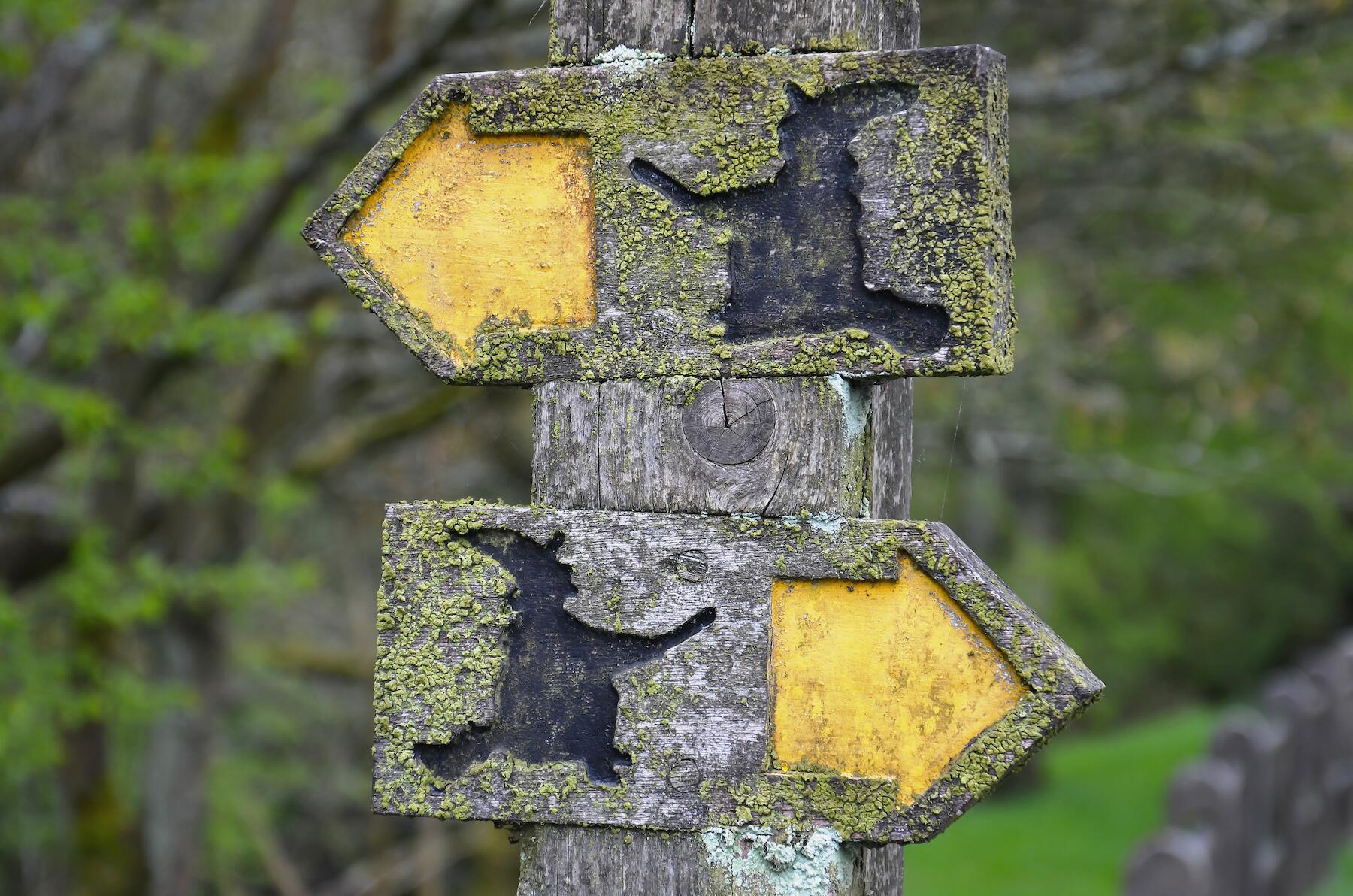Long before the Salem Witch trials in Massachusets, there were the Pendle Witch trials in England.
In the hilltop village of Newchurch-in-Pendle in Lancashire, northern England, a shop sign written in archaic English exhorts passers-by to part with their hard-earned cash.
“Gerrit spent,” it reads, “they don’t pupockits i shrahds.” Or, in modern parlance: “Get it spent. They don’t put pockets in shrouds.” Adorning the front of the spooky gift shop Witches Galore, the sign is a reminder that we can’t take our money with us when we die, so we may as well spend it on mugs, dishtowels, tarot cards, and stuffed toy witches while we still have the chance.
I was visiting, appropriately enough, on Halloween, when Newchurch and the surrounding villages are at their most ghoulish. Full-size plastic skeletons and cartoon witches commune on rooftops and park benches, spray-on cobwebs cloud window panes, and signposts are topped with pumpkins and fake animal skulls. There’s a good reason why this corner of the country has a particularly strong fixation on all things macabre: It was the site, in 1612, of the most notorious witch trial in British history, with 10 people being put to death in a storm of blackmail and hysteria.
Recommended Fodor’s Video
I was in Pendle to walk a stretch of the route–neatly marketed as the Pendle Witch Trail–along which the accused were taken for their trial at Lancaster Castle. As I moved through the landscape of rolling green valleys, chocolate-box villages, and bucolic woodland, it was hard to imagine that such strange and terrible events could have taken place here. In fact, the disconnect between the historical horror and the kitsch, cutesy modern repackaging–right down to the trail’s signposts, which feature silhouetted witches on broomsticks–led me to wonder why the likes of me are drawn to places like this.
“These places are stepping stones back into the cultural trauma of our past,” said Dr. Philip Stone, director of the Institute for Dark Tourism Research at the University of Central Lancaster. “We go to places where tragedy has happened, and we mediate our sense of our own mortality through the eyes of others, who could have been you or I in another time. We’re also searching for answers–why did these things happen?”
Before the Salem Witch Trials, There Were the Pendle Witch Trials
The Pendle Witch Trials–so-called because they involved people from a group of villages around local landmark Pendle Hill–came at a time when the British Isles were swept up in a wave of widespread hysteria around witchcraft. If you think the British royal family is dramatic today, try imagining the year 1603, when Elizabeth I was replaced on the throne by James I. A man possessed of a fervent religious imagination, James had already written a lengthy treatise on witch hunting, werewolves, and vampires (1597’s Daemonologie), and was convinced that a group of Scottish witches was plotting his murder. It was a time, in Britain and across Europe, when different religious and cultural paradigms were jostling for supremacy–particularly Protestantism vs. Catholicism–and an era of drought, wars, and pestilence. In times like these, society creates heroes and villains in an attempt to impose an easily understandable framework on a chaotic world.
“Witch trials are a means of setting social boundaries–picking an enemy to persecute, imagining a complete reversal of everything your society values, and then alleging that someone is practicing that evil,” explained Professor Marion Gibson, an academic in witchcraft and magic at the University of Exeter.
Here’s how that process went down in Pendle. It had been illegal in Britain since the mid-1500s to attempt to use witchcraft in order to harm others, but many people were known in rural communities as traditional healers, using herbal remedies to cure sickness alongside charms or spells. One such person was Elizabeth Southerns, known locally as Demdike. One morning in March 1612, Demdike’s granddaughter, Alizon Device, had an encounter with a pedlar named John Law, from whom she allegedly attempted to buy or beg metal pins. Law refused, and a few minutes later, fell down, apparently crippled, his symptoms similar to those of a stroke. Soon enough, Alison’s entire family, along with several other local people, were being accused of maleficium–performing witchcraft with the intent of causing harm, injury, or death. In total, 12 people were accused; 10 ended up being put to death.
Events in Pendle would have a direct influence on the witch trials in Salem, Massachusetts, in the 1690s.
“The merchants and Puritans who went to America carried English witchcraft beliefs with them,” said Gibson. “As early as 1626, there was a prosecution in Virginia, and the 1692 Salem trials featured stories very similar to English trials.”
Pendle set a particularly chilling precedent for Salem in permitting a child to stand as a witness. Nine-year-old Jennet Device, Alison’s sister, gave testimony in court, which led to her entire family being killed.
In the village of Roughlee, a couple of miles’ walk east of Newchurch, I stumble upon a statue depicting Alice Nutter, one of those killed in the witch trials, with her hands in chains. Nutter was the only one of the accused to plead not guilty and is widely considered to have been an innocent victim.
But what were other accused witches, in Pendle, Salem, and elsewhere, really up to? The consensus has changed over time. In the 18th and 19th centuries–a time when science and reason were in the ascendancy–it was widely believed that all those convicted of witchcraft were innocent victims, like Alice. Then, in the 1920s, a theory emerged that many witches were, in fact, members of a witch cult, a pre-Christian pagan religion centered around the worship of a horned fertility god. This theory has since been discredited.
Nowadays, a more nuanced view tends to hold sway: that some of the accused witches, at least, really did believe they were practicing witchcraft, both to benefit and harm others, even if they can’t have had such an effect in reality.
“It appears they did believe they were practicing magic,” said Gibson. “They talked about performing spells to heal animals, a kind of good magic that village healers did. People like the accused witches–who were very poor–could make money from this.”
Gibson also said, “They described making clay images of people in order to crumble them and harm victims, which is something they could have done. They might have done it out of malice or to turn back spells on people thought to have bewitched them.”
This isn’t to say that they were not victims of circumstance and prejudice.
“Some witches may have tried to harm neighbors by magic, but many were magical healers or completely innocent of any magical activity,” said Gibson. “They seem to have been picked on because they were poor, usually women, and were thought to be a social problem: disorderly, immoral, aggressive beggars and a burden on society.”
Looking Back at a Painful Past
Today, the Pendle Witch Trail gives visitors the chance to walk in the footsteps of these unfortunate souls–through the villages of Barley and Blacko, largely unchanged in 400 years, and the beautiful Forest of Bowland, which surrounds them. But it also gives us a chance to relive their stories, restore them to some dignity, and, perhaps, give us a bit of perspective when we’re tempted to complain about our own lives.
“If dark tourism can provoke the question of why these things happened, then it’s done its job,” said Stone. “In the West, death is often hidden behind closed doors—dark tourism brings it back into the public realm.”
“Pendle,” he concludes, “is where the supernatural and the natural collide.”







